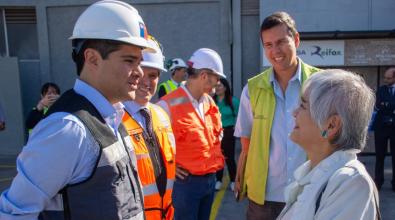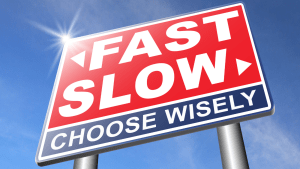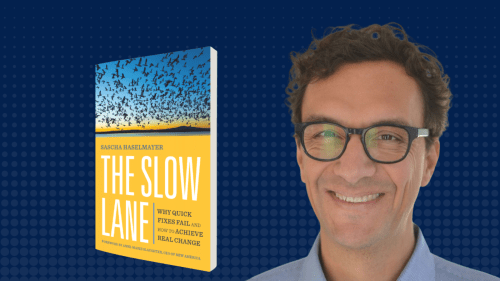 Read More
Read More
How city leaders can get big things done in the ‘slow lane’

In an age of big challenges, high expectations, and short news cycles, local leaders face more pressure than ever to deliver quick fixes. But they should resist the urge to always act fast, according to social entrepreneur Sascha Haselmayer, who, in his new book “The Slow Lane,” argues that effective change requires that cities pump the brakes from time to time.
That’s because, Haselmayer explains, there’s no way to truly solve complex problems in sustainable ways without also creating and holding space to meaningfully engage with, learn from, and build trust among affected communities. And that takes time.
Haselmayer draws on his decades of experience working in city innovation—currently at Ashoka and previously helping cities take creative approaches to procurement—and cites examples from government, business, and social movements to spotlight five principles that can help leaders embrace “slow lane” approaches to innovation. His ideas, which work hand-in-hand with critical capacities Bloomberg Philanthropies helps build within local governments, such as civic engagement, co-creation, collaboration, and design-led innovation, include:
- hold the urgency and don’t rush to action
- listen to the people impacted by change
- share agency with them
- nurture curiosity and seek new ideas, and
- use technology as an enabler of change, not a silver bullet.
We spoke with Haselmayer to learn more about how local leaders can achieve impact in the slow lane. Here are four takeaways.
It’s not easy to get out of the fast lane.
The search for quick fixes exerts a strong gravitational pull on local leaders. “That’s because it plays on our fears,” says Haselmayer, whose first recommendation is that city leaders resist urgency in order to “move at the speed of trust.” When problems are big and the stakes are high, “we feel more comfortable doing something than observing and listening. We look for whatever seems to fit, and then jump into action.”
That impulse looms even larger for mayors and others in the public eye. “They often think that, at a moment of crisis, you have to demonstrate your leadership by taking responsibility, owning the problem, and having the right answer right away. The fact is that rarely works.”
The slow lane isn’t about moving slowly—it’s about building long-term change that sticks.
Haselmayer cites numerous examples of social and economic change, from national to local, that rode the slow lane to success, including Iceland’s approach to the financial crisis of 2007-08. While countries like Spain rushed to bail out banks and suffered high unemployment that continues today, Iceland took a slower approach: leveraging experience and insights gained through an earlier slow-lane effort—sharing agency with residents in the creation of a new constitution—to expand the social safety net. As a result, Iceland experienced a much faster recovery than other countries.
At a more local scale, he points to changes in the New York City neighborhood of Brownsville, where a decade-plus collaboration between residents and service providers helped fuel efforts that bridged deep disparities in access to the city’s services for young children with developmental delays. New pathways for accessing services weren’t created overnight, but were the result of the collective insight and experience of the 50-plus organizations that make up the nonprofit Brownsville Partnership.
Once foundational relationships and trust are in place, slow-lane change can take place in what sometimes feels like overnight. “What the slow lane shows is that these movements can turn audacious ideas into reality,” Haselmayer says. “Take marriage equality—it happened because people pursued that idea for 45 years with a very clear compass.”
Success in the slow lane means rethinking how government listens and learns.
Local governments take in a lot of community input, but Haselmayer says too much of this is a box-checking exercise aimed at validating plans that are well underway—what he calls a “theater of listening.” By contrast, when local leaders invite residents into the decision-making process, they also empower them to bring forward and even implement new ideas.
Haselmayer looks to Sefton, U.K., a city of 275,000, as an example of how listening to and working with impacted communities can make a big difference. Facing massive budget cuts, the city’s social services director was tasked with zeroing out a service that brought hot meals to hundreds of vulnerable residents. Instead of simply and immediately cutting the program and moving on, he asked volunteers to meet with the people who received these meals and listen to their needs. It turned out that what these people needed as much as meals was companionship—they were lonely. So in addition to finding a way to continue a meal service without a government subsidy, the city also partnered with a charity to connect people with social activities.
The lesson: Governments need to learn how to not only listen, but do so with empathy and understanding. “I can tell you I’m listening to you—but it’s only when you tell me you feel listened to that it’s true,” Haselmayer says. “This is what the slow lane is really about: What it takes to really listen to someone. And how you have to let go of your expectation of timeframes when you commit yourself to that act.”
Take time to strengthen—and better tap—community expertise.
As local governments share agency with communities, they can do so with another of Haselmayer’s principles in mind—nurturing curiosity and finding new ways to uncover fresh ideas. The community-led change in Brownsville was propelled by the partnership’s key decision to hire well-connected neighborhood residents and then send them to Harvard University to learn more about community organizing. Similarly, the resulting successes with early-intervention programs were based on the lived experiences of local families that were paid for their expertise and participation.
Haselmayer also uplifts the example of a London prison where budget cuts had degraded living conditions and safety. The leader in charge formed a prison council to tap the ideas of prisoners themselves for low-cost ways to improve conditions. This new way of listening built on the efforts of Mark Johnson, a social entrepreneur who, after serving time himself, crafted a model that helped improve probation outcomes by training 127,000 ex-offenders to take an active role in their probation.
Social entrepreneurs like Johnson should be of particular interest to city leaders looking to take slow-lane approaches to problem solving, adds Haselmayer, who estimates that there are 50 million such people in the world, working in every city of every size.
“If I were a mayor, I would look very carefully at who these people are and how I can connect with them,” he recommends. “They have the trust of communities, they’re not lobbyists or people asking for specific policies, and they’re creating exciting solutions that governments can really get behind in new ways.”


